The Leaf
The Leaf Definition: The green, flattened, exogenously growing lateral appendages of stems are called leaves.
The Leaf Characteristics:
- A typical leaf consists of leaf base» petiole and lamina.
- Leaves always contain buds in their axil
- The lamina has veins and veinlets, which help in the conduction of food and water across the eaves and other parts of plants.
- In some plants, structures called stipules are present at the leaf base.
- The leaves develop exogenously from the nodes of the stems and branches.
Read and Learn More: WBCHSE Notes for Class 11 Biology
Different Parts Of A Typical Leaf And Their Functions
A typical leaf has three main parts—
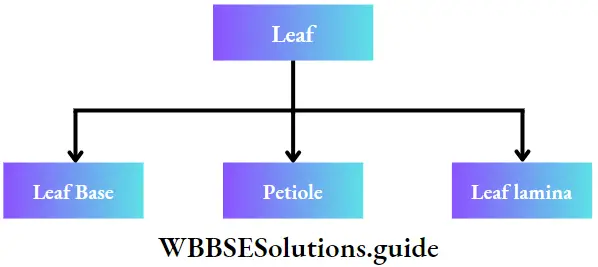
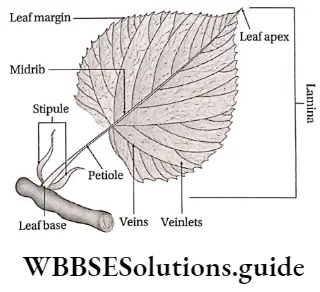
Leafbase Or Hypopodium
Hypopodium Definition: The lowermost portion of a leaf, which remains attached to the stem or branch is called the leaf base.
| Class 11 Biology | Class 11 Chemistry |
| Class 11 Chemistry | Class 11 Physics |
| Class 11 Biology MCQs | Class 11 Physics MCQs |
| Class 11 Biology | Class 11 Physics Notes |
Hypopodium Function: It attaches the leaf firmly to the branch or the stem.
Hypopodium Types: Different types of hypopodium are discussed as follows.
Morphology of leaf structure and its modifications
Pulvinus: These swollen cushion-like, leaf bases, This type of leaf base is found in Mimosa pudica and Mangifera indica.

” modifications of leaves”
Amplexicaul: Sometimes, the leaf base becomes flattened and it forms a complete sheath around the internodal region of the stem, known as amplexicaul. This type of leaf base is also known as sheathing leaf base. This type of leaf base is found in Polygonum sp., Aethusa cynapium, etc.
Semi-amplexicaul: In most monocotyledonous plants the leaf base becomes flattened and forms a partial sheath around the internodel region of the stem as seen in palm leaves.
It is called the semi-amplexicaul type. This is also a type of sheathing leaf base. In some plants, the leaf bases become much extended to form a stem-like structure. This type of leaf base is found in Musa balbisiana and Musa paradisiaca.
Decurrent: In certain plants, the leaf base and petiole both become flat, broad, and winged. They form a sheath around the internodal region of the stem. This is known as a decurrent leaf base. This type of leaf base is found in Symphytum officinale, Laggera sp.
Types of leaves and their modifications with examples
Ligule: Ligule is the membranous, scaly, or hairy tongue-like outgrowth that occurs at the sheathing leaf base. This structure is commonly found in grasses, Oryza sativa, etc.
Auricle: The auricle is the winged expansion of the leaf base, which is continuous with the lamina. Common examples of this type of leaf base are Oryza sativa, Aegialitis rotundifolia, Lonicera caprifolium, etc.
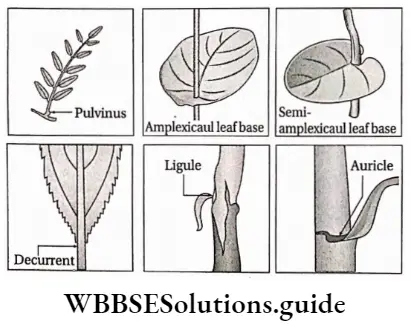
Classification of leaves on the basis of life span
Leaves are of three types based on their life span—caducous, deciduous, and persistent.
- Caducous or fugacious: The leaves that fall off in their early stages of development, are known as caducous leaves. example, Acacia recurve.
- Deciduous or annual: The leaves that fall off after one growing season are known as deciduous leaves. example Bombax ceiba (silk cotton), and Ficus benghalensis (banyan).
- Persistent or evergreen or perennial: The leaves that persist and remain active for more than one season and fall off after aging are known as evergreen leaves. example Artocarpus heterophyllus (jack), Mangifera indica (mango).
Detailed structure of a leaf with labeled diagram
Complete and incomplete leaves, leaf scar
- Complete leaf: The leaf that consists of all three parts (leaf base, petiole, and lamina) is known as a complete leaf. example mango leaf.
- Incomplete leaf: A leaf that lacks any of the three parts is known as an incomplete leaf. example petiole is absent in the leaf of Calotropis sp
- Leaf scar: The mark left by a leaf after it falls off from the stem, is known as the leaf scar.
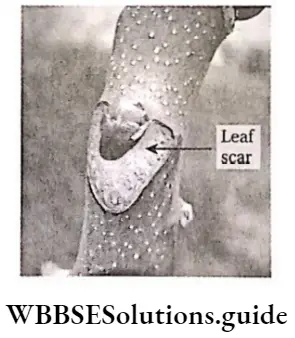
Petiole or mesopodium or leafstalk
Petiole or mesopodium or leafstalk Definition: The connecting region of the leaf base and leaf blade is referred to as the petiole.
Usually, petioles are solid and cylindrical (for example, Ficus religiosa), but they can be flattened, grooved, or soft (for example Musa paradisiaca) or a hollow tube (for example Carica papaya).
Petiole or mesopodium or leafstalk Location: It usually remains attached to the base and the posterior part of the leaf lamina. On the basis of the presence or absence of petiole, leaves are of different types.
Petiolate leaf: The leaves with petioles are known as petiolate leaves. example Hibiscus sp.
Sessile leaf: The leaves without petioles are known as sessile leaves. exampleGloriosa superba.
Peltate leaf: The leaves where the petioles remain attached to the lower surface of lamina, are known as peltate leaves. This gives the leaf a shield-like appearance. example lotus (Nelumbo nucifera).
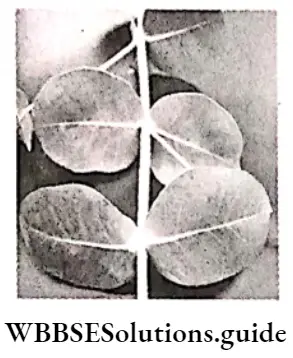
“structure of leaf diagram “
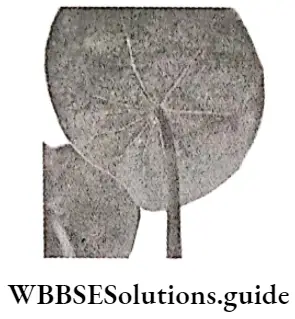
Modification of petioles: The petioles can be modified in various ways. They are—
Winged petiole: In this case, the petiole becomes flattened and wing-shaped. It looks like leaf lamina and is involved in photosynthesis. example Citrus sp. In Nepenthes sp., the petiole becomes partly winged and partly tendrillar.
Swollen or bulbous petiole: This type of petiole is filled with air and becomes swollen and spongy. It is observed in some aquatic plants. This structure helps the plant to float on water. example Trapa bispinosa, Eichhornia crassipes, etc.
Phyllode: Seedlings of some plants bear normal compound leaves. After maturation, these leaves fall off. The petioles then become flattened and look like foliage leaves. These are known as phyllodes. This type of petiole decreases the rate of transpiration and takes part in photosynthesis. example Acacia sp.
Simple and compound leaf types with examples
Tendrillar petiole: In some plants, the petiole takes the shape of a tendril and helps the plant to climb upwards. This type of petiole is called tendrillar petiole, for example, Aristolochia indica, Clematis gouriana, etc.
Spiny petiole: The lamina falls off after maturation, leaving behind the petiole that gradually develops into a rigid spine. example Quisqualis malabaricum.
Functions of petiole:
- It helps in the transportation of nutrients and water in and out of the leaf.
- It can orient the leaf lamina to get sufficient light for photosynthesis.
- Some plants have swollen and spongy petioles. Such a petiole helps the plant to float on water.
- Petioles get modified and help the plant in various ways. For example, the tendrillar petiole helps the plant to climb up on a support.
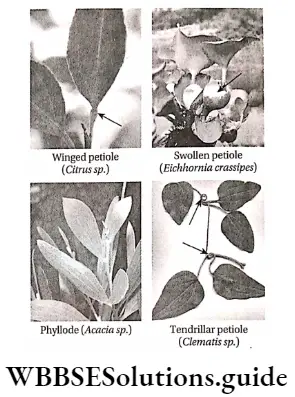
Leafblade or epipodium or lamina
Leaf-blade or epipodium or lamina Definition: The green, thin, and expanded apical portion of the leaf is called the leaf blade.
Leafblade or epipodium or lamina Characteristics:
- The leaf blade or lamina is usually thin and dorsoventrally differentiated.
- A strong vein runs from base to apex through the middle of the lamina. It is called the midrib (main vein). Smaller and thinner veins grow from the midrib and may divide again into minute branches, called veinlets. The veins may run parallel to the midrib or form a reticulate arrangement along with the veinlets. Thus, two types of venation are found
- Reticulate venation and
- Parallel venation.
“parts of the leaf and their functions “
Leaf-blade Functions:
- Lamina contains chlorophyll and carries out photosynthesis.
- The lamina bears stomata and thus helps in gaseous exchange.
- The veins of leaves, help in the conduction of water and food into the lamina.
Variations in lamina: Lamina shows many variations in shape, margin, surface, etc.
The shape of Lamina: The shape of the lamina depends on the apex, length of the leaf, and the terminal end Different types of lamina are described below.
Lamina has almost the same width throughout
- Acicular: Lamina is needle-shaped. example Pinus sp.
- Linear: Lamina is long, flat, narrow, and almost uniform in width. example,tube-rose, rice, wheat, grasses, etc.
- Lanceolate: Lamina is like a lance, i.e., broader in the middle portion and gradually tapers towards both ends. example Nerium indicum, Polygonum orientate, etc.
- Oblong: Lamina is more or less rectangular and elongated. example Musa paradisiaca, Musa balbisiana, etc
- Falcate: Lamina is like a sickle or a beak of a falcon. example Carya illinoinensis, Acacia falcata, etc.
Lamina is widest at the base
- Subulate or awl-shaped: The long and narrow lamina tapers gradually towards the apex. Examples are Salsola kali, Isoetes sp., etc.
- Ovate or egg-shaped: The base of the lamina is wider than the round apex. example Banyan, china-rose, etc.
- Cordate: The lamina is heart-shaped. example Piper betel, Sida cordifolia, and Abutilon indicum.
- Sagittate: The lamina is arrow-shaped. example Sagittaria sagittifolia, Ipomoea aquatica, etc.
- Hastate: Lamina is arrow-shaped,r but the two lower lobes are directed outwards. Example Jyphonium trilobatum, etc.
- Reniform or kidney-shaped: The lamina is bean or kidney-shaped. exampleCentella asiatica.
- Lunate: Lamina is half-moon-shaped with pointed basal lobes. example Adiantum lunatum, Passiflora lunata, etc.
Leaf modifications in different plants with examples
Lamina is widest at the apex
- Obovate: The shape of the lamina is like an inverted egg (reverse of ovate). Example lamina of Artocorpus heterophyllus, cassia obovata, etc.
- Obcordate: The shape of the lamina is like an inverted heart example variegata, Oxalis corniculata, etc.
- Spathulate or spathe-shaped: The Leaf lamina of some plants becomes broad and rounded at the apex and gradually becomes narrow towards the base. example lamina of Phyla nodiflora, Duranta repens, etc.
- Cuneate or wedge-shaped: Lamina looks like the hood of a snake. example Pistia stratiotes.
- Lyrate: Lamina looks like a lyre (an instrument) having a large oval terminal lobe and two or more smaller lobes. example lamina of Raphanus sativus, Brassica nigra, etc.
Lamina which is symmetrical
- Elliptical or oval: Lamina looks like an ellipse. example Ficus elastica, Psidium guajava, etc.
- Orbicular (circular) or rotund or peltiform: In certain plants, the shape of the lamina is circular and the petiole is attached at the lower surface of the leaf. example Nelumbo nucifera (lotus).
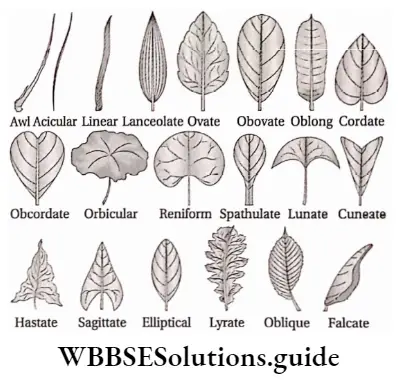
Base lamina:
The base of the lamina may be of the following types—
Auriculate: The sessile leaves form two lobe-like wings at the base, which partially encircle the stem. example Argemone mexicana.
Perfoliate: The lobes of the sessile leaf at the base fuse and the leaf encircles the stem completely example Consent perfoliate.
Connate: the type, the bases of two sess.le leaves with opposite PhVllPtaxy are fused together completely. exampleCanscora diffusa, Swertia chirata, etc.
Decurren: Winged leaf base is fused to the stem example Laggera alata, Sphaeranthus indicus, etc.
The surface of Lamina: The surface of the lamina is of different types—
Glabrous: Both the surface of the lamina is smooth and hairless. examplePongamia glabra, Dianthus chinensis.
Glaucous: In some plants, the surface of the lamina bears a waxy covering and thus, appears to be shiny. example Solarium glaucoma.
“types of leaves with names “
Viscose: The surface of the lamina becomes sticky due to the viscous exudation of secretory glands present in leaves. exampleCleome viscosa and Polanisia icosandra, etc.
Scabrous: The surface of the lamina becomes rough due to elevated tiny rigid hair-like structures. example, Ficus hispida.
Venation in leaves and its types with diagram
Rugose: The surface of the lamina appears a little bit wrinkled. example., Rubus rugosus.
Gland-dotted: The surface of the lamina remains covered with glands. example Citrus auratifolia.
Hairy: The surface of the lamina is covered with hairs. example, Calotropis sp., tomato.
Spinose: The surface of the lamina is covered with small prickles. example brinjal.
Margin of Lamina:
The margin of the lamina can be of the following types—
Entire: Margin is smooth and devoid of any notch. example Mangifera indica, Ficus benghalensis, etc.
Serrate: Margin of lamina appears as saw teeth, pointed upwards. example, Hibiscus rosa-sinensis.
Biserrate: In this lamina the toothed margin is further serrated upwards. example, elm tree.
Retroserrate: Margin is toothed and pointed downwards. example leaves of dandelion.
Repand: In this type, the margin is wavy with notches. example Polyalthia longifolia.
Dentate: Margin is toothed and the teeth are pointed outward at right angles to the midrib. example water-lily.
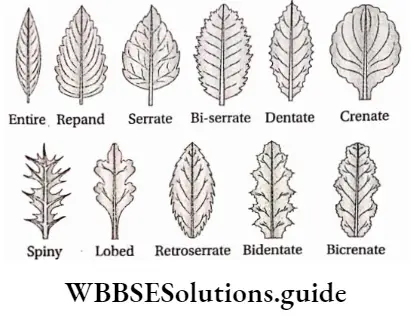
Bidentate: Margins are toothed and the teeth are further dentate. example Carex oxylepis.
Create: The margins are marked with a rounded tooth. example, Centella Asiatica.
Bicrenate: Margin is toothed. Each tooth of the margin is again divided into rounded teeth.
Spiny: The teeth apices of the dentate margin become pointed and form spines. example Argemone mexicana, Solarium xanthocarpum, etc.
Incised or lobed: Margin is cut into various depths and divided into small lobes. example Brassica nigra, Raphanus sativus.
Apex of Lamina: Different leaf lamina bears different types of apices (singular: apex).
Acute: Apex is pointed and narrow. example found in Mangifera indica, Hibiscus rosa-sinensis, etc.
Acuminate: Apex is slender and prolonged like a long tapering tail. example Ficus religiosa, Bauhinia acuminata, etc.
Obtuse: Apex is blunt with a large terminal angle. example Ficus benghalensis (banyan).
Mucronate: Apex is broad and forms a sharp point. example Catharanthus roseus
Cuspidate or spiny: Apex forms a hard, pointed structure. example Phoenix sylvestris, Agave cantula, etc.
Tendrillar: The leaf apex is narrow, and elongated and forms a tendril. example Gloriosa Superba.
Cirrhose: Apex ends in a fine coiled or curved thread-like structure. example Musa paradisiaca.
Phyllotaxy in plants – types and examples
Truncate: Apex is cut across almost at a right angle to the midrib. example Indigofera linifolia, Paris polyphylla, etc.
Refuse: Apex is obtuse and slightly notched. example, found in Clitorea ternatea, Pistia stratiotes, etc.
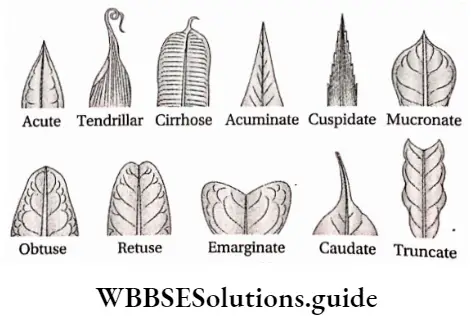
Emarginate: Apex is obtuse and deeply notched, for example, found in Bauhinia variegata.
Leaf morphology important questions for NEET and exams
Coriaceous: Thick and leathery leaf lamina, as found in Mangifera indica.
Herbaceous: Thin and membranous leaf lamina, as found in Hibiscus rosa-sinensis.
Succulent: Fleshy and brittle leaf lamina, as found in Aloe indica.
Gland-dotted or glandular: Dotted and glandular leaf lamina. The glands are filled with essential oils, as found in Citrus limon.
